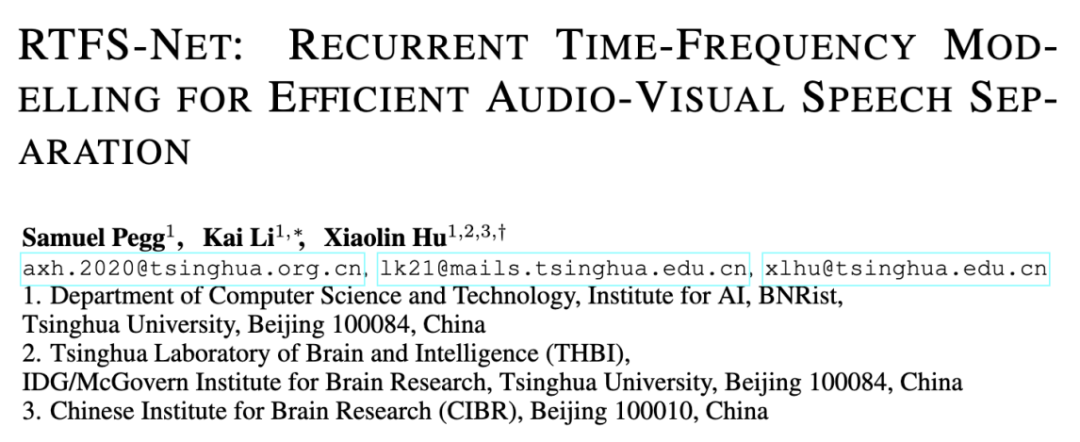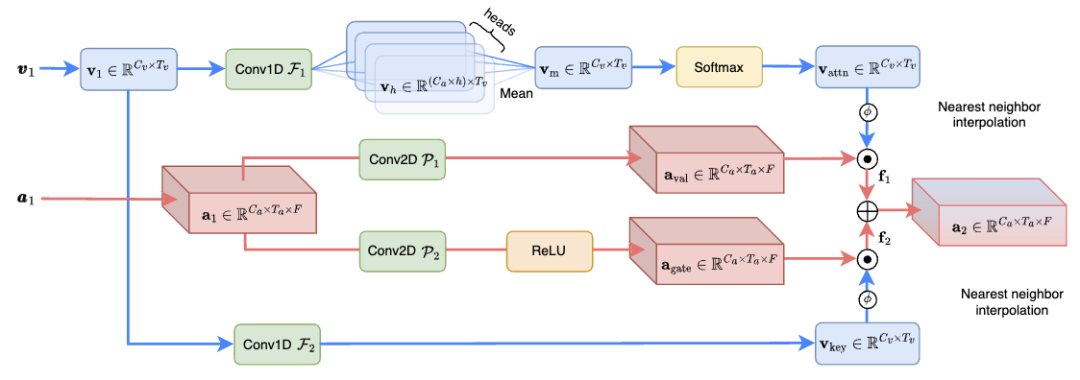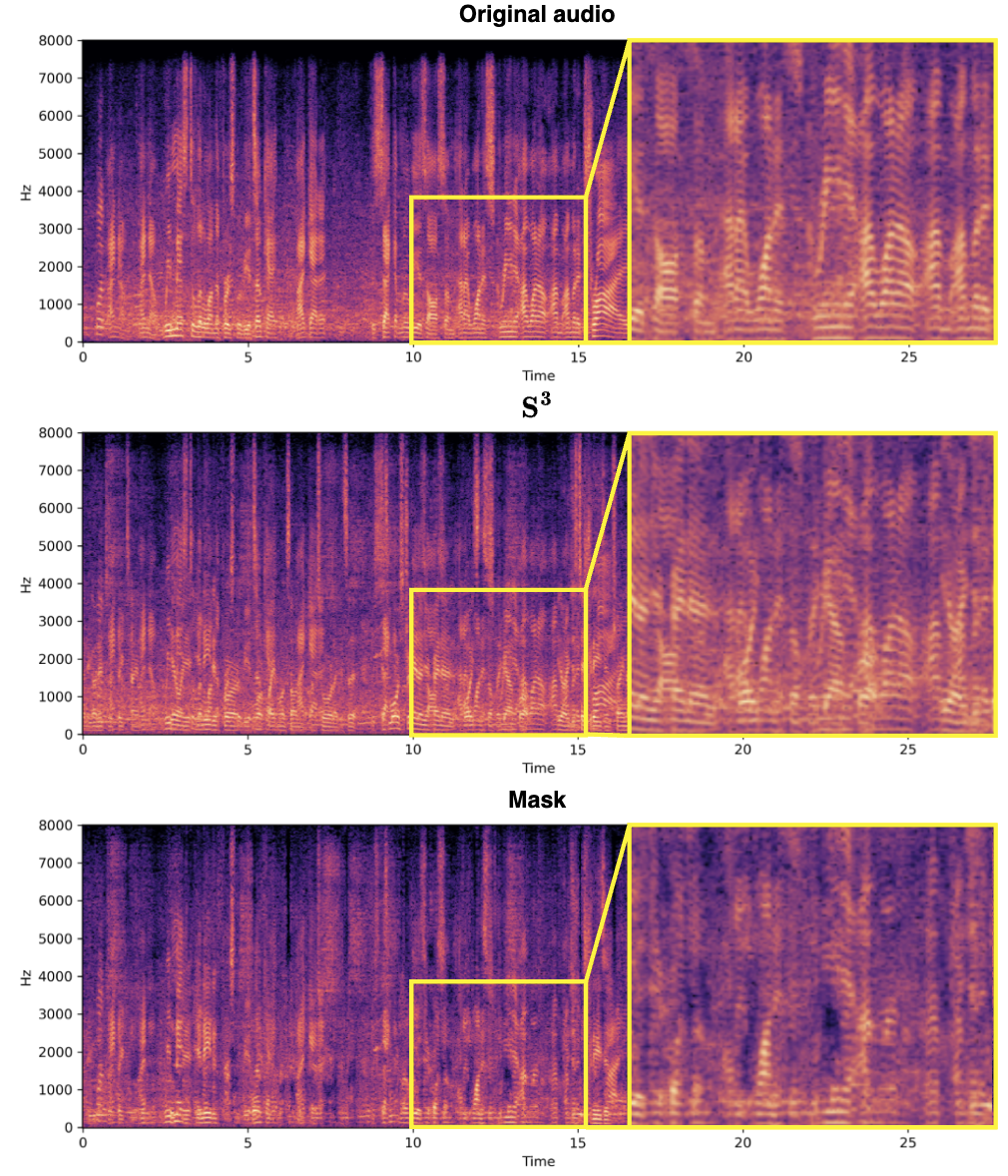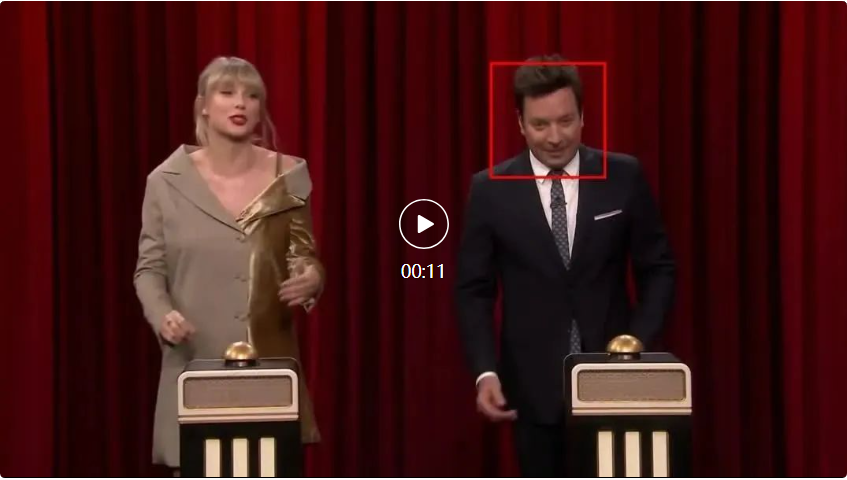 Technology peripherals
Technology peripherals
 AI
AI
 ICLR 2024 | Providing a new perspective for audio and video separation, Tsinghua University's Hu Xiaolin team launched RTFS-Net
ICLR 2024 | Providing a new perspective for audio and video separation, Tsinghua University's Hu Xiaolin team launched RTFS-Net
ICLR 2024 | Providing a new perspective for audio and video separation, Tsinghua University's Hu Xiaolin team launched RTFS-Net
The main purpose of Audiovisual Speech Separation (AVSS) technology is to identify and separate the target speaker's voice in a mixed signal, using facial information to achieve this goal. This technology has wide applications in multiple fields, including smart assistants, remote conferencing, and augmented reality. Through AVSS technology, the quality of speech signals in noisy environments can be significantly improved, thereby improving the effects of speech recognition and communication. The development of this technology has brought convenience to people's daily life and work, making it easier for people to
Traditional audio-visual speech separation methods usually require complex models and a large amount of computing resources, especially when there are noisy Its performance is easily limited in background or multi-speaker situations. To overcome these problems, researchers began to explore deep learning-based methods. However, existing deep learning technology has the challenges of high computational complexity and difficulty in adapting to unknown environments.
Specifically, the current audio-visual speech separation method has the following problems:
Time domain method: It can provide high-quality audio separation effect, but due to many parameters, The computational complexity is high and the processing speed is slow.
Time-frequency domain methods: more computationally efficient, but historically have performed poorly compared to time domain methods. They face three main challenges:
#1. Lack of independent modeling of time and frequency dimensions.
2. Visual cues from multiple receptive fields are not fully utilized to improve model performance.
3. Improper processing of complex features leads to the loss of critical amplitude and phase information.
In order to deal with these challenges, researchers from the team of Associate Professor Hu Xiaolin of Tsinghua University proposed a new audio-visual speech separation model called RTFS-Net. The model adopts a compression-reconstruction method, which significantly reduces the computational complexity and number of parameters of the model while improving separation performance. RTFS-Net is the first audiovisual speech separation method using less than 1 million parameters, and it is also the first method to outperform all time domain models in time-frequency domain multi-modal separation.

Paper address: https://arxiv.org/abs/2309.17189
Paper home page: https://cslikai.cn/RTFS-Net/AV-Model-Demo.html
Code address: https://github.com/spkgyk/RTFS-Net (coming soon) )
Method introduction
The overall network architecture of RTFS-Net is shown in Figure 1 below:

Figure 1. Network framework of RTFS-Net
Among them, the RTFS block (shown in Figure 2) is responsible for the acoustic dimensions (time and frequency) ) for compression and independent modeling, minimizing information loss while creating low-complexity subspaces. Specifically, the RTFS block employs a dual-path architecture for efficient processing of audio signals in both time and frequency dimensions. With this approach, RTFS blocks are able to reduce computational complexity while maintaining high sensitivity and accuracy to audio signals. The following is the specific workflow of the RTFS block:
1. Time-frequency compression: The RTFS block first compresses the input audio features in the time and frequency dimensions.
2. Independent dimension modeling: After completing the compression, the RTFS block independently models the time and frequency dimensions.
3. Dimension fusion: After processing the time and frequency dimensions independently, the RTFS block merges the information of the two dimensions through a fusion module.
4. Reconstruction and output: Finally, the fused features are reconstructed back to the original time-frequency space through a series of deconvolution layers.

## 图 2. The network structure of the RTFS block
# (CAF) module (As shown in Figure 3) Effectively fuses audio and visual information, enhances speech separation effect, and the computational complexity is only 1.3% of the previous SOTA method. Specifically, the CAF module first generates attention weights using depth and grouped convolution operations. These weights dynamically adjust based on the importance of input features, allowing the model to focus on the most relevant information. Then, by applying the generated attention weights to visual and auditory features, the CAF module is able to focus on key information in multiple dimensions. This step involves weighting and fusing features of different dimensions to produce a comprehensive feature representation. In addition to the attention mechanism, the CAF module can also adopt a gating mechanism to further control the degree of fusion of different source features. This approach can enhance the flexibility of the model and allow finer information flow control.

## Figure 3. Schematic structural diagram of the CAF fusion module
Design of spectrum source separation (S^3) block The idea is to use the spectral information represented by complex numbers to effectively extract the speech features of the target speaker from the mixed audio. This method makes full use of the phase and amplitude information of the audio signal, improving the accuracy and efficiency of source separation. And using a complex network enables the S^3 block to process the signal more accurately when isolating the speech of the target speaker, especially in preserving details and reducing artifacts, as shown below. Likewise, the design of the S^3 block allows easy integration into different audio processing frameworks, is suitable for a variety of source separation tasks, and has good generalization capabilities.
Experimental results
Separation effect
In On three benchmark multi-modal speech separation datasets (LRS2, LRS3 and VoxCeleb2), as shown below, RTFS-Net approaches or exceeds the current state-of-the-art performance while significantly reducing model parameters and computational complexity. The trade-off between efficiency and performance is demonstrated through variants with different numbers of RTFS blocks (4, 6, 12 blocks), where RTFS-Net-6 provides a good balance of performance and efficiency. RTFS-Net-12 performed best on all tested data sets, proving the advantages of time-frequency domain methods in handling complex audio and video synchronization separation tasks.
actual effect
Mixed video: Female speaker audio:
Female speaker audio:  Male speaker audio:
Male speaker audio: 
Summary
With the continuous development of large model technology, audio-visual speech separation The field is also pursuing large models to improve separation quality. However, this is not feasible for end devices. RTFS-Net achieves significant performance improvements while maintaining significantly reduced computational complexity and number of parameters. This demonstrates that improving AVSS performance does not necessarily require larger models, but rather innovative, efficient architectures that better capture the intricate interplay between audio and visual modalities.The above is the detailed content of ICLR 2024 | Providing a new perspective for audio and video separation, Tsinghua University's Hu Xiaolin team launched RTFS-Net. For more information, please follow other related articles on the PHP Chinese website!

Hot AI Tools

Undresser.AI Undress
AI-powered app for creating realistic nude photos

AI Clothes Remover
Online AI tool for removing clothes from photos.

Undress AI Tool
Undress images for free

Clothoff.io
AI clothes remover

Video Face Swap
Swap faces in any video effortlessly with our completely free AI face swap tool!

Hot Article

Hot Tools

Notepad++7.3.1
Easy-to-use and free code editor

SublimeText3 Chinese version
Chinese version, very easy to use

Zend Studio 13.0.1
Powerful PHP integrated development environment

Dreamweaver CS6
Visual web development tools

SublimeText3 Mac version
God-level code editing software (SublimeText3)

Hot Topics
 DeepMind robot plays table tennis, and its forehand and backhand slip into the air, completely defeating human beginners
Aug 09, 2024 pm 04:01 PM
DeepMind robot plays table tennis, and its forehand and backhand slip into the air, completely defeating human beginners
Aug 09, 2024 pm 04:01 PM
But maybe he can’t defeat the old man in the park? The Paris Olympic Games are in full swing, and table tennis has attracted much attention. At the same time, robots have also made new breakthroughs in playing table tennis. Just now, DeepMind proposed the first learning robot agent that can reach the level of human amateur players in competitive table tennis. Paper address: https://arxiv.org/pdf/2408.03906 How good is the DeepMind robot at playing table tennis? Probably on par with human amateur players: both forehand and backhand: the opponent uses a variety of playing styles, and the robot can also withstand: receiving serves with different spins: However, the intensity of the game does not seem to be as intense as the old man in the park. For robots, table tennis
 The first mechanical claw! Yuanluobao appeared at the 2024 World Robot Conference and released the first chess robot that can enter the home
Aug 21, 2024 pm 07:33 PM
The first mechanical claw! Yuanluobao appeared at the 2024 World Robot Conference and released the first chess robot that can enter the home
Aug 21, 2024 pm 07:33 PM
On August 21, the 2024 World Robot Conference was grandly held in Beijing. SenseTime's home robot brand "Yuanluobot SenseRobot" has unveiled its entire family of products, and recently released the Yuanluobot AI chess-playing robot - Chess Professional Edition (hereinafter referred to as "Yuanluobot SenseRobot"), becoming the world's first A chess robot for the home. As the third chess-playing robot product of Yuanluobo, the new Guoxiang robot has undergone a large number of special technical upgrades and innovations in AI and engineering machinery. For the first time, it has realized the ability to pick up three-dimensional chess pieces through mechanical claws on a home robot, and perform human-machine Functions such as chess playing, everyone playing chess, notation review, etc.
 Claude has become lazy too! Netizen: Learn to give yourself a holiday
Sep 02, 2024 pm 01:56 PM
Claude has become lazy too! Netizen: Learn to give yourself a holiday
Sep 02, 2024 pm 01:56 PM
The start of school is about to begin, and it’s not just the students who are about to start the new semester who should take care of themselves, but also the large AI models. Some time ago, Reddit was filled with netizens complaining that Claude was getting lazy. "Its level has dropped a lot, it often pauses, and even the output becomes very short. In the first week of release, it could translate a full 4-page document at once, but now it can't even output half a page!" https:// www.reddit.com/r/ClaudeAI/comments/1by8rw8/something_just_feels_wrong_with_claude_in_the/ in a post titled "Totally disappointed with Claude", full of
 At the World Robot Conference, this domestic robot carrying 'the hope of future elderly care' was surrounded
Aug 22, 2024 pm 10:35 PM
At the World Robot Conference, this domestic robot carrying 'the hope of future elderly care' was surrounded
Aug 22, 2024 pm 10:35 PM
At the World Robot Conference being held in Beijing, the display of humanoid robots has become the absolute focus of the scene. At the Stardust Intelligent booth, the AI robot assistant S1 performed three major performances of dulcimer, martial arts, and calligraphy in one exhibition area, capable of both literary and martial arts. , attracted a large number of professional audiences and media. The elegant playing on the elastic strings allows the S1 to demonstrate fine operation and absolute control with speed, strength and precision. CCTV News conducted a special report on the imitation learning and intelligent control behind "Calligraphy". Company founder Lai Jie explained that behind the silky movements, the hardware side pursues the best force control and the most human-like body indicators (speed, load) etc.), but on the AI side, the real movement data of people is collected, allowing the robot to become stronger when it encounters a strong situation and learn to evolve quickly. And agile
 ACL 2024 Awards Announced: One of the Best Papers on Oracle Deciphering by HuaTech, GloVe Time Test Award
Aug 15, 2024 pm 04:37 PM
ACL 2024 Awards Announced: One of the Best Papers on Oracle Deciphering by HuaTech, GloVe Time Test Award
Aug 15, 2024 pm 04:37 PM
At this ACL conference, contributors have gained a lot. The six-day ACL2024 is being held in Bangkok, Thailand. ACL is the top international conference in the field of computational linguistics and natural language processing. It is organized by the International Association for Computational Linguistics and is held annually. ACL has always ranked first in academic influence in the field of NLP, and it is also a CCF-A recommended conference. This year's ACL conference is the 62nd and has received more than 400 cutting-edge works in the field of NLP. Yesterday afternoon, the conference announced the best paper and other awards. This time, there are 7 Best Paper Awards (two unpublished), 1 Best Theme Paper Award, and 35 Outstanding Paper Awards. The conference also awarded 3 Resource Paper Awards (ResourceAward) and Social Impact Award (
 Hongmeng Smart Travel S9 and full-scenario new product launch conference, a number of blockbuster new products were released together
Aug 08, 2024 am 07:02 AM
Hongmeng Smart Travel S9 and full-scenario new product launch conference, a number of blockbuster new products were released together
Aug 08, 2024 am 07:02 AM
This afternoon, Hongmeng Zhixing officially welcomed new brands and new cars. On August 6, Huawei held the Hongmeng Smart Xingxing S9 and Huawei full-scenario new product launch conference, bringing the panoramic smart flagship sedan Xiangjie S9, the new M7Pro and Huawei novaFlip, MatePad Pro 12.2 inches, the new MatePad Air, Huawei Bisheng With many new all-scenario smart products including the laser printer X1 series, FreeBuds6i, WATCHFIT3 and smart screen S5Pro, from smart travel, smart office to smart wear, Huawei continues to build a full-scenario smart ecosystem to bring consumers a smart experience of the Internet of Everything. Hongmeng Zhixing: In-depth empowerment to promote the upgrading of the smart car industry Huawei joins hands with Chinese automotive industry partners to provide
 Li Feifei's team proposed ReKep to give robots spatial intelligence and integrate GPT-4o
Sep 03, 2024 pm 05:18 PM
Li Feifei's team proposed ReKep to give robots spatial intelligence and integrate GPT-4o
Sep 03, 2024 pm 05:18 PM
Deep integration of vision and robot learning. When two robot hands work together smoothly to fold clothes, pour tea, and pack shoes, coupled with the 1X humanoid robot NEO that has been making headlines recently, you may have a feeling: we seem to be entering the age of robots. In fact, these silky movements are the product of advanced robotic technology + exquisite frame design + multi-modal large models. We know that useful robots often require complex and exquisite interactions with the environment, and the environment can be represented as constraints in the spatial and temporal domains. For example, if you want a robot to pour tea, the robot first needs to grasp the handle of the teapot and keep it upright without spilling the tea, then move it smoothly until the mouth of the pot is aligned with the mouth of the cup, and then tilt the teapot at a certain angle. . this
 Distributed Artificial Intelligence Conference DAI 2024 Call for Papers: Agent Day, Richard Sutton, the father of reinforcement learning, will attend! Yan Shuicheng, Sergey Levine and DeepMind scientists will give keynote speeches
Aug 22, 2024 pm 08:02 PM
Distributed Artificial Intelligence Conference DAI 2024 Call for Papers: Agent Day, Richard Sutton, the father of reinforcement learning, will attend! Yan Shuicheng, Sergey Levine and DeepMind scientists will give keynote speeches
Aug 22, 2024 pm 08:02 PM
Conference Introduction With the rapid development of science and technology, artificial intelligence has become an important force in promoting social progress. In this era, we are fortunate to witness and participate in the innovation and application of Distributed Artificial Intelligence (DAI). Distributed artificial intelligence is an important branch of the field of artificial intelligence, which has attracted more and more attention in recent years. Agents based on large language models (LLM) have suddenly emerged. By combining the powerful language understanding and generation capabilities of large models, they have shown great potential in natural language interaction, knowledge reasoning, task planning, etc. AIAgent is taking over the big language model and has become a hot topic in the current AI circle. Au





